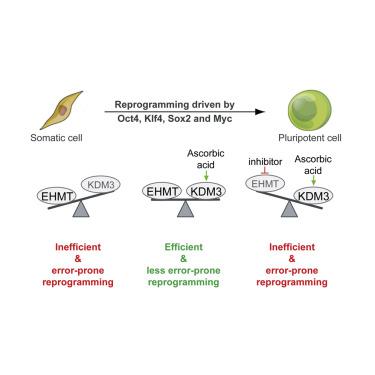Stem Cell Reports ( IF 5.9 ) Pub Date : 2020-09-24 , DOI: 10.1016/j.stemcr.2020.08.011 Simon E Vidal 1 , Alexander Polyzos 2 , Kaushiki Chatterjee 2 , Ly-Sha Ee 3 , Emily Swanzey 4 , Jorge Morales-Valencia 5 , Hongsu Wang 6 , Chaitanya N Parikh 2 , Bhishma Amlani 7 , Shengjiang Tu 8 , Yixiao Gong 9 , Valentina Snetkova 10 , Jane A Skok 10 , Aristotelis Tsirigos 11 , Sangyong Kim 12 , Effie Apostolou 2 , Matthias Stadtfeld 3

|
Methylation of histone 3 at lysine 9 (H3K9) constitutes a roadblock for cellular reprogramming. Interference with methyltransferases or activation of demethylases by the cofactor ascorbic acid (AA) facilitates the derivation of induced pluripotent stem cells (iPSCs), but possible interactions between specific methyltransferases and AA treatment remain insufficiently explored. We show that chemical inhibition of the methyltransferases EHMT1 and EHMT2 counteracts iPSC formation in an enhanced reprogramming system in the presence of AA, an effect that is dependent on EHMT1. EHMT inhibition during enhanced reprogramming is associated with rapid loss of H3K9 dimethylation, inefficient downregulation of somatic genes, and failed mesenchymal-to-epithelial transition. Furthermore, transient EHMT inhibition during reprogramming yields iPSCs that fail to efficiently give rise to viable mice upon blastocyst injection. Our observations establish novel functions of H3K9 methyltransferases and suggest that a functional balance between AA-stimulated enzymes and EHMTs supports efficient and less error-prone iPSC reprogramming to pluripotency.
中文翻译:

重编程为多能性期间对常染色质组蛋白甲基转移酶活性的上下文相关要求。
组蛋白 3 在赖氨酸 9 (H3K9) 处的甲基化构成了细胞重编程的障碍。辅因子抗坏血酸 (AA) 对甲基转移酶的干扰或去甲基化酶的激活促进了诱导多能干细胞 (iPSC) 的产生,但特定甲基转移酶与 AA 治疗之间可能的相互作用仍未得到充分探索。我们表明,在存在 AA 的情况下,甲基转移酶 EHMT1 和 EHMT2 的化学抑制会在增强的重编程系统中抵消 iPSC 的形成,这种作用依赖于 EHMT1。增强重编程期间的 EHMT 抑制与 H3K9 二甲基化的快速丧失、体细胞基因的低效下调以及间充质到上皮转化失败有关。此外,重编程期间的瞬时 EHMT 抑制产生 iPSC,在注射囊胚后无法有效地产生存活的小鼠。我们的观察建立了 H3K9 甲基转移酶的新功能,并表明 AA 刺激的酶和 EHMT 之间的功能平衡支持有效且不易出错的 iPSC 重编程为多能性。











































 京公网安备 11010802027423号
京公网安备 11010802027423号